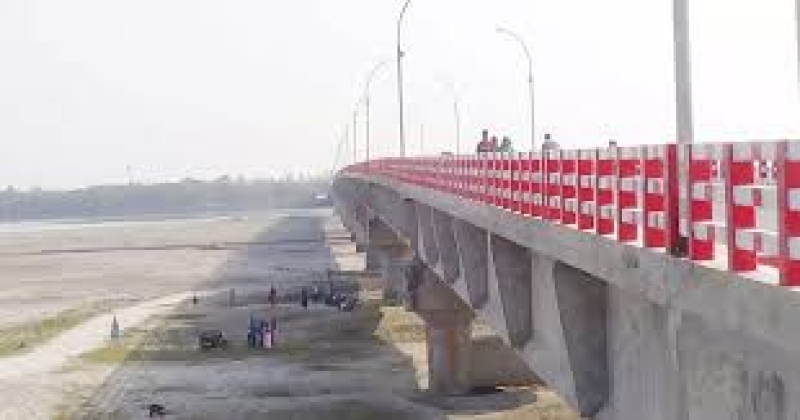- Dhaka residents struggling with ‘unhealthy’ air quality |
- Over 100 Killed in Brazil’s Deadliest Rio Police Raid |
- Alphabet Tops $100 Billion Quarter as AI Drives Surge |
- Wild bird meat raid in Sylhet’s Jaintiapur: 2 hotels sealed, 1 fined |
- Reported massacre at hospital in Sudan’s El Fasher leaves 460 dead |
Teesta dries up after 5 flood waves, northern Bangladesh at risk

Once a mighty river that breathed life into northern Bangladesh, the Teesta now lies silent and broken, as its shimmering waters replaced by stretches of sand and its flow reduced to a faint memory for the millions who once depended on it.
The lifeline of two crore people lies gasping for breath as its waters vanishing, its banks eroding and its people left clinging to the memories of a river that once defined their existence.
Once a symbol of abundance, locals said, the Teesta today survives only in fragments, swelling briefly during monsoon, then receding into a barren desert of cracked sandbanks as winter approaches. The river’s decline has plunged the lives of Teesta basin residents into uncertainty, threatening their farms, fisheries and future.
By late October, the mighty Teesta had already dried up, long before the arrival of the dry season.
According to the Water Development Board (WDB), water flow at the Teesta Barrage point over the past 10 days averaged only 17,000 cusecs and continues to drop daily.
As the water disappears, so too does the livelihood of thousands. Farmers and fishermen along the Teesta’s banks say they are ‘dying along with the river’, WDB officials said.
Experts trace the beginning of this decline to the construction of India’s barrages at Gajoldoba near the Teesta’s entry point and at Doani in Lalmonirhat, which disrupted the river’s natural flow. Over time, its life-giving waters have been diverted through canals, leaving vast stretches of the riverbed dry.
Standing along the Teesta today, one can almost hear what locals describe as the ‘sigh of a dying river’, echoing across endless sand where strong currents once flowed.
The river’s navigability has dropped so drastically that irrigation under the Teesta Barrage — the country’s largest irrigation project — may face severe challenges in the coming dry season. Large parts of the riverbed now lie exposed, marked only by shallow pools and scattered dunes, according to the officials.
Originating from Himalayan glaciers, the Teesta flows through India’s Sikkim, Darjeeling and Jalpaiguri before entering Bangladesh through Dahagram in Lalmonirhat. From there, it meanders through Nilphamari, Rangpur and Gaibandha before merging with the Brahmaputra. Once, its fertile chars produced rice, jute, maize, sesame and vegetables in abundance, shaping the region’s agriculture, culture and livelihoods.
However, the construction of the Gajoldoba Barrage in 1983 disrupted Teesta’s natural course — triggering water shortages in dry months and devastating floods in monsoon.
According to WDB data, more than 20,000 families have been displaced by river erosion in the past decade, with nearly 35 kilometres of riverbank severely eroded. Recently, a 350-metre stretch of the Teesta bridge protection embankment at Mahipur in Lalmonirhat caved into the river.
In Kurigram’s Ulipur upazila, over 100 homes have been lost to erosion, while in Gangachara more than 50 families have been displaced. Hundreds more remain marooned in four villages of Rajarhat upazila.
For years, residents of northern Bangladesh have taken to the streets under the slogan ‘Save Teesta, Save North Bengal’.
Environmental activists and locals have recently organised human chains, sit-ins and torch processions across Rangpur division, demanding immediate action.
During a recent 48-hour campaign along the 115-kilometre river stretch, thousands from Lalmonirhat, Kurigram, Nilphamari, Rangpur and Gaibandha joined to demand the long-delayed Bangladesh-India Teesta water-sharing agreement and implementation of the Teesta Master Plan.
The proposed master plan includes river dredging, rehabilitation of char dwellers and repair of embankments, with an estimated cost of Tk 8,000 crore.
According to sources in the Teesta River Protection Movement, Syeda Rizwana Hasan, advisor to the Ministry of Water Resources, confirmed that work on the Teesta Master Plan will begin in January 2026. The 10-year project will be implemented in two phases at a total cost of Tk 12,000 crore — with Tk 6,700 crore financed through Chinese loans and Tk 2,450 crore from government funds in the first phase.
Teesta River Protection Movement coordinator and BNP central organising secretary Asadul Habib Dulu warned that if the government fails to start the project with its own funds before the election schedule is announced, a larger movement will be launched with Teesta basin residents.
“The government has already allocated Tk 2,450 crore for the first phase. It’s time for action, not promises,” he said.
Ahsan Habib, superintending engineer of the WDB’s Rangpur region, said the Teesta’s water level has been falling since mid-October due to sedimentation.
He, however, assured that the barrage still holds sufficient water for the upcoming irrigation season, while stressing the urgent need for large-scale dredging.
River expert Dr Tuhin Wadud warned that unless the Teesta is scientifically dredged, the entire northern region could eventually turn into a desert, reports UNB.
“The Teesta’s decline has already disrupted the natural rhythm of the region’s seasons. India’s unilateral withdrawal of water has killed the river and now it is the government’s responsibility to save it,” he said.
As the Teesta continues to shrink, its once vibrant rhythm is being replaced by silence — and with it, the fate of millions who depend on its flow hangs in the balance, Wadud added.

